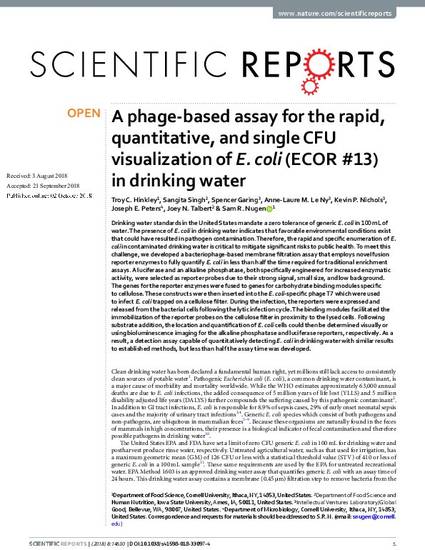
Drinking water standards in the United States mandate a zero tolerance of generic E. coli in 100mL of water. The presence of E. coli in drinking water indicates that favorable environmental conditions exist that could have resulted in pathogen contamination. Therefore, the rapid and specifc enumeration of E. coli in contaminated drinking water is critical to mitigate signifcant risks to public health. To meet this challenge, we developed a bacteriophage-based membrane fltration assay that employs novel fusion reporter enzymes to fully quantify E. coli in less than half the time required for traditional enrichment assays. A luciferase and an alkaline phosphatase, both specifcally engineered for increased enzymatic activity, were selected as reporter probes due to their strong signal, small size, and low background. The genes for the reporter enzymes were fused to genes for carbohydrate binding modules specifc to cellulose. These constructs were then inserted into the E. coli-specifc phage T7 which were used to infect E. coli trapped on a cellulose flter. During the infection, the reporters were expressed and released from the bacterial cells following the lytic infection cycle. The binding modules facilitated the immobilization of the reporter probes on the cellulose flter in proximity to the lysed cells. Following substrate addition, the location and quantifcation of E. coli cells could then be determined visually or using bioluminescence imaging for the alkaline phosphatase and luciferase reporters, respectively. As a result, a detection assay capable of quantitatively detecting E. coli in drinking water with similar results to established methods, but less than half the assay time was developed.
Available at: http://works.bepress.com/joey_talbert/3/

This article is published as Hinkley, T.C., Singh,S., Garing, S., Le Ny,A.L.M., Nichols, K.P., Peters, J.E., Talbert, J.N., Nugen, S.R., A phage-based assay for the rapid, quantitative, and single CFU visualization of E. coli (ECOR #13) in drinking water. Scientific Reports, 2018 (8); 14630. DOI: 10.1038/s41598-018-33097-4.